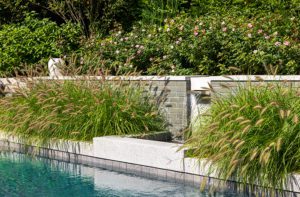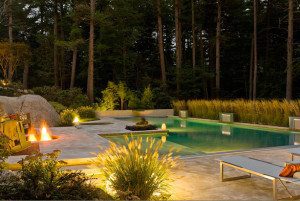A Changing Landscape
June 1, 2018
SPONSORED CONTENT
Text by Kaitlin Madden



The biggest trend in New England landscape architecture at the moment? Bucking tradition.
A decade ago, New England landscapes most often took cues from the site: the style of the home, the feel of the neighborhood, the microclimates on the property. Today, on the other hand, it can seem like inspiration can come from just about anywhere.
“Thanks to sites like Instagram, Pinterest, and Houzz, people come into our office with photos of homes in Australia and California and Japan,” says Gregory Lombardi, owner of Gregory Lombardi Design, a landscape architecture firm in Cambridge “Our clients’ desires are transcending regionalism. They’re not just being influenced by their surroundings anymore.”
At its core, says Lombardi, the shift in aesthetics represents a broader change in mindset: today’s homeowners value individualism—often regardless of what the style of their home or neighborhood might dictate. “People want something made specifically for them. They don’t want to be part of the collective or confined to certain rules,” he says. “They may have a very traditional home in a very traditional neighborhood, but they’ll come into our office and say something like, ‘We moved here from the city and this style isn’t really us,’ so they want to go in a much more contemporary direction with the landscape.”
Lombardi’s challenge, then, becomes to conceive a design that honors the homeowner’s request, while creating a sense of connection between the property and what might be a contrasting style. “Sometimes, it’s almost like people are trying too hard to create a landscape that feels curated,” Lombardi says, “There’s a dissonance in the things they’re choosing to put together just to achieve something that feels individualized. In order to be unique but end up with a design that still enriches the site, it requires a juxtaposition of the two different styles you’re trying to marry—you have to have enough of each one to make it feel unified.”
As a designer, Lombardi admits to happily welcoming the challenge of these non-traditional requests, but that’s not to say that adapting an exterior from southern California to suit a site on Cape Cod is always easy, or straightforward. “Clients are often inspired by travel, and while inspiration from other parts of the world might be translatable for our area, not all of it is,” he says.
He means that from both practical and aesthetic standpoints.
Practically speaking, most of the challenges that come with recreating a look that’s not endemic to the Northeast is making it work for the climate. “Lately, everyone loves minimalist, taupey-gray limestone, for example, but there aren’t a lot of stones that work in the New England freeze-thaw climate. We aren’t able to find suppliers willing to warranty limestone through one of our winters. The materials we work with here have to be non-absorbent and really durable,” Lombardi explains.
From a stylistic standpoint, Lombardi toes the line between a design that defies convention and one that simply creates conflict. “I’ve seen houses in Cambridge and Newton that are very naturalist and organic, which might work well in a town like Lincoln, but for urban situations can end up feeling a little messy. City landscapes require a certain amount of discipline,” he says.
To overcome any challenges that arise during the inspiration phase, Lombardi and his firm have a process for finding a happy medium—one he jokingly refers to as their version of Rorschach testing. “We’ll show our clients a bunch of photos to try and break down the essence of what they want, and figure out if they like clean lines and edges, or if they’re after something natural-looking and less produced,” he explains. “A lot of times people will react very viscerally, like ‘Oh no, that’s not what we’re thinking at all,’ or ‘Yes! That’s exactly what we want.’ ” From there, he and his team can work to create something that gets at the soul of an initial idea or inspiration photo, but is appropriate for the site, too.
Overall, Lombardi says this broad new perspective on design has been beneficial for both his firm and his clients. “Our motto as a firm has always been that we don’t have a signature style. We’re very driven by what our clients want,” he says. “Our design process is about taking the client’s inspiration and finding a personalized and befitting solution that takes the site, home, budget, and timeline into an account.”
Gregory Lombardi Design
Cambridge and Chatham, Massachusetts
lombardidesign.com
Share
![NEH-Logo_Black[1] NEH-Logo_Black[1]](https://b2915716.smushcdn.com/2915716/wp-content/uploads/2022/08/NEH-Logo_Black1-300x162.jpg?lossy=1&strip=1&webp=1)













You must be logged in to post a comment.